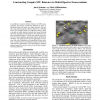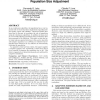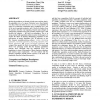52 search results - page 2 / 11 » On the effect of populations in evolutionary multi-objective... |
AIIDE
2008
13 years 7 months ago
2008
It is difficult to discover effective behavior for NPCs automatically. For instance, evolutionary methods can learn sophisticated behaviors based on a single objective, but realis...
GECCO
2007
Springer
13 years 11 months ago
2007
Springer
There exist a number of high-performance Multi-Objective Evolutionary Algorithms (MOEAs) for solving MultiObjective Optimization (MOO) problems; two of the best are NSGA-II and -M...
GECCO
2006
Springer
13 years 9 months ago
2006
Springer
In an evolutionary algorithm, the population has a very important role as its size has direct implications regarding solution quality, speed, and reliability. Theoretical studies ...
SAC
2008
ACM
13 years 4 months ago
2008
ACM
Biological populations are dynamic in both space and time, that is, the population size of a species fluctuates across their habitats over time. There are rarely any static or fix...
GECCO
2011
Springer
12 years 8 months ago
2011
Springer
The rate of speciation is in most mammals an order of magnitude faster than in most other vertebrates. It is faster still in the social mammals. The apparent association between c...



